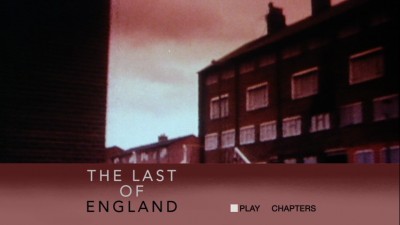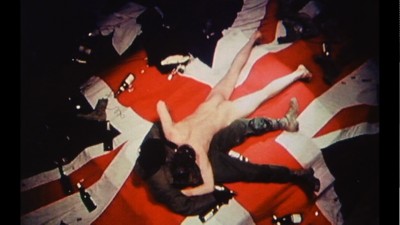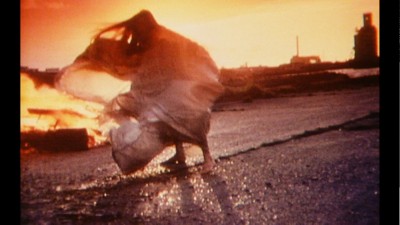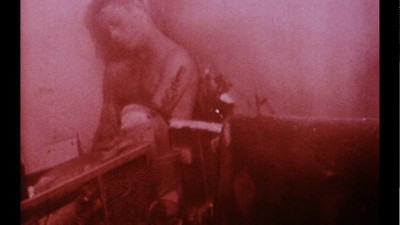| Reviews & Columns |
|
Reviews DVD TV on DVD Blu-ray 4K UHD International DVDs In Theaters Reviews by Studio Video Games Features Collector Series DVDs Easter Egg Database Interviews DVD Talk Radio Feature Articles Columns Anime Talk DVD Savant Horror DVDs The M.O.D. Squad Art House HD Talk Silent DVD
|
DVD Talk Forum |
|
|
| Resources |
|
DVD Price Search Customer Service #'s RCE Info Links |
|
Columns
|
|
|
Last of England, The
THE MOVIE:

Derek Jarman was both punk rock auteur and sensitive artist, and his obsession with life's shabby beauty is given an excellent vehicle in his 1987 film, The Last of England.
The Last of England is ostensibly a post-apocalyptic motion picture, a divergent future made possible by Margaret Thatcher's conservative politics and all the misery they entailed. The film is not really science fiction, nor is it in any way conventional in terms of narrative. It's more collage than story, more like a performance piece than genre cinema. Cut to the music of Barry Adamson, Diamanda Galas, Marianne Faithfull, and others, Jarman's film has a lot in common with 1980s music videos--a few of which he was even responsible for. (He directed clips for the Smiths, Pet Shop Boys, and Suede.) The Last of England isn't a film you watch to track characters or plots; instead, you measure moods and follow dream-like impulses.
In a way, I suppose you could call The Last of England a travelogue. It's Jarman's tour of England after the fall, narrated by a Nostradamus figure in the form of Nigel Terry (though, in the flesh, it's Jarman), who fittingly enough played King Arthur in Excalibur. Armed with the poetry of Eliot and Ginsberg, Terry explains where it all went wrong while Jarman's camera surveys the rubble. Punks and teddy boys and pretty-faced nihilists scratch out a survival while masked soldiers impose an ill-defined order. In the midst of the devastation, Jarman splices in home movies from his own family, showing the promise of childhood and all that could have been, juxtaposing it with everything that might be. It's a kind of present nostalgia: neither the past nor the invented future are real, they are not the right now. Yet Jarman longs for what both images refute.

The final scenes of the film offer a sort of rebuilding of normalcy and a rejection of the same. A young Tilda Swinton (I Am Love) emerges as a focal character, and in keeping with the other elements of The Last of England, she appears as both a figure of the past and a survivor of the apocalypse. We see her first as a girl-next-door type, wearing a summer dress, enjoying a day outdoors; we see her second as a bride going through the pageantry of a wedding ceremony, surrounded by drag queens, forcing a smile. The woman rejects the ostentation and costuming and retreats to the beach, where she dances by a bonfire. Jarman shoots the performance lovingly, slowing down the film, blowing out the colors, extending the moment and freezing it. Despite all that has happened, has this lone figure found her happiness and expression? Or is it a lament for a world that can ever be the same? Jarman did not shy away from presenting The Last of England as a AIDS allegory, and in a world ravaged by HIV, love has come to mean different things.
Perhaps it is all these things, perhaps it is none. It's my first time seeing The Last of England, and indeed, only my second full-length Derek Jarman film overall. I don't yet have a confident handle on his vocabulary. Even so, my instinct says that there is no set code, his movies are amorphous. The Last of England can be whatever you want it to be in the moment, and from viewing to viewing, how you interpret what you see might change. Since there is not much that is stable enough to latch onto, you just have to let it happen, let it move you, and succumb to the beautiful, disturbing chaos.

THE DVD
Video:
IMDB says that The Last of England was shot on both 8 mm and 35 mm (and indeed, my colleague Christopher McQuain, in his review of the new Blu-Ray of The Last of England, guesses there is also some 16 mm), and the DIY aesthetic that Jarman embraced shows through in this new DVD. The film is presented at a 1.66:1 aspect ratio, and some of the remnants of the source material show through. There are jagged lines, as well as some fuzzy edges, but these don't detract from the viewing; rather, the lack of perfection is part of Jarman's aesthetic. His people are imperfect, as is his whole world.
Sound:
The new stereo mix sounds great. The music has a lot of force and volume, and the narration is balanced nicely against it. (There is no dialogue.) Some of the sound effects maybe sound too clear, but I am also guessing that is by design, that Jarman wasn't going for realism, he was creating a superimposed surreality. There is a little bit of speaker interplay in some of the more varied sequences, but for the most part, the soundtrack is full and immersive, taking over both channels in equal measure.
Extras:
None.
FINAL THOUGHTS:
Recommended. Derek Jarman's The Last of England is an experimental work, to be sure, but one that shows a clear line of thought and a commitment to an aesthetic idea. Imagine it as an art installation for your television set. Told mostly through images and music, this survey of Jarman's vision for a post-Thatcher apocalypse is haunting, unnerving, and also beautiful and totally mesmerizing. I'm not going to pretend that I entirely "get it," or that you will either, but The Last of England is the kind of arthouse endeavor that inspires patience and rewards tenacity. If you can meet Jarman even halfway by bringing one or the other, then you'll find plenty of value in his creation.

Jamie S. Rich is a novelist and comic book writer. He is best known for his collaborations with Joelle Jones, including the hardboiled crime comic book You Have Killed Me, the challenging romance 12 Reasons Why I Love Her, and the 2007 prose novel Have You Seen the Horizon Lately?, for which Jones did the cover. All three were published by Oni Press. His most recent projects include the futuristic romance A Boy and a Girl with Natalie Nourigat; Archer Coe and the Thousand Natural Shocks, a loopy crime tale drawn by Dan Christensen; and the horror miniseries Madame Frankenstein, a collaboration with Megan Levens. Follow Rich's blog at Confessions123.com.
|
| Popular Reviews |
| Sponsored Links |
|
|
| Sponsored Links |
|
|
| Release List | Reviews | Shop | Newsletter | Forum | DVD Giveaways | Blu-Ray | Advertise |
|
Copyright 2024 DVDTalk.com All Rights Reserved. Legal Info, Privacy Policy, Terms of Use,
Manage Preferences,
Your Privacy Choices | |||||||













